
How to Use 4 channel relay module 5V JD-VCC: Examples, Pinouts, and Specs
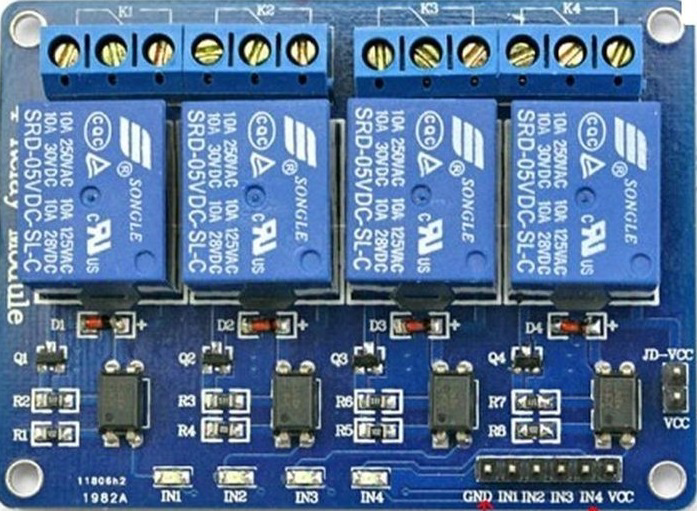
 Design with 4 channel relay module 5V JD-VCC in Cirkit Designer
Design with 4 channel relay module 5V JD-VCC in Cirkit DesignerIntroduction
The 4 Channel Relay Module 5V JD-VCC is an electronic component designed to control up to four independent devices using low-power control signals. It operates on a 5V power supply and features an optocoupler-based isolation mechanism, ensuring safe and reliable operation in automation and control systems. The JD-VCC pin allows the relay power to be isolated from the control signal, reducing electrical noise and protecting sensitive microcontrollers.
Explore Projects Built with 4 channel relay module 5V JD-VCC
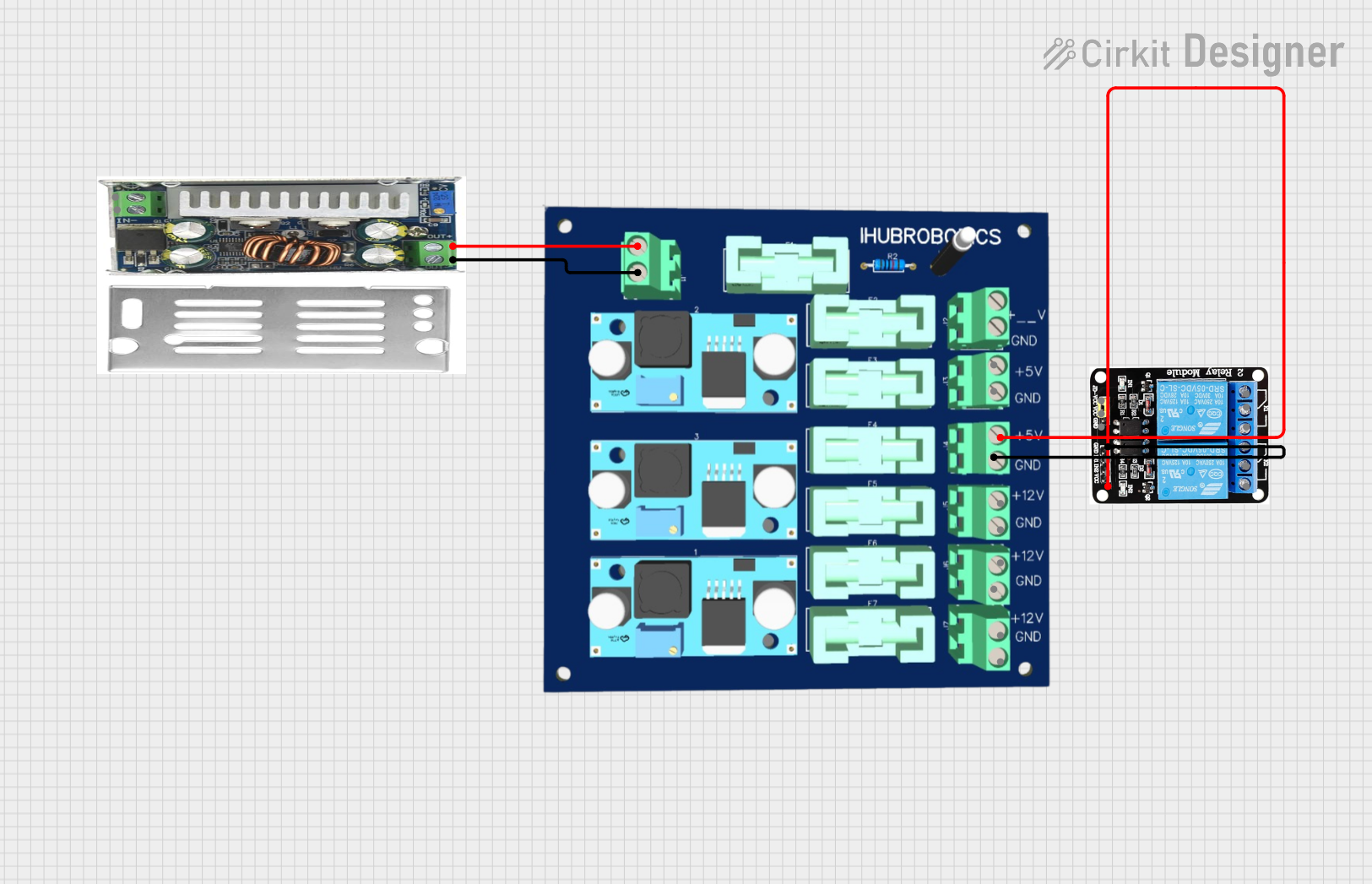
 Open Project in Cirkit Designer
Open Project in Cirkit Designer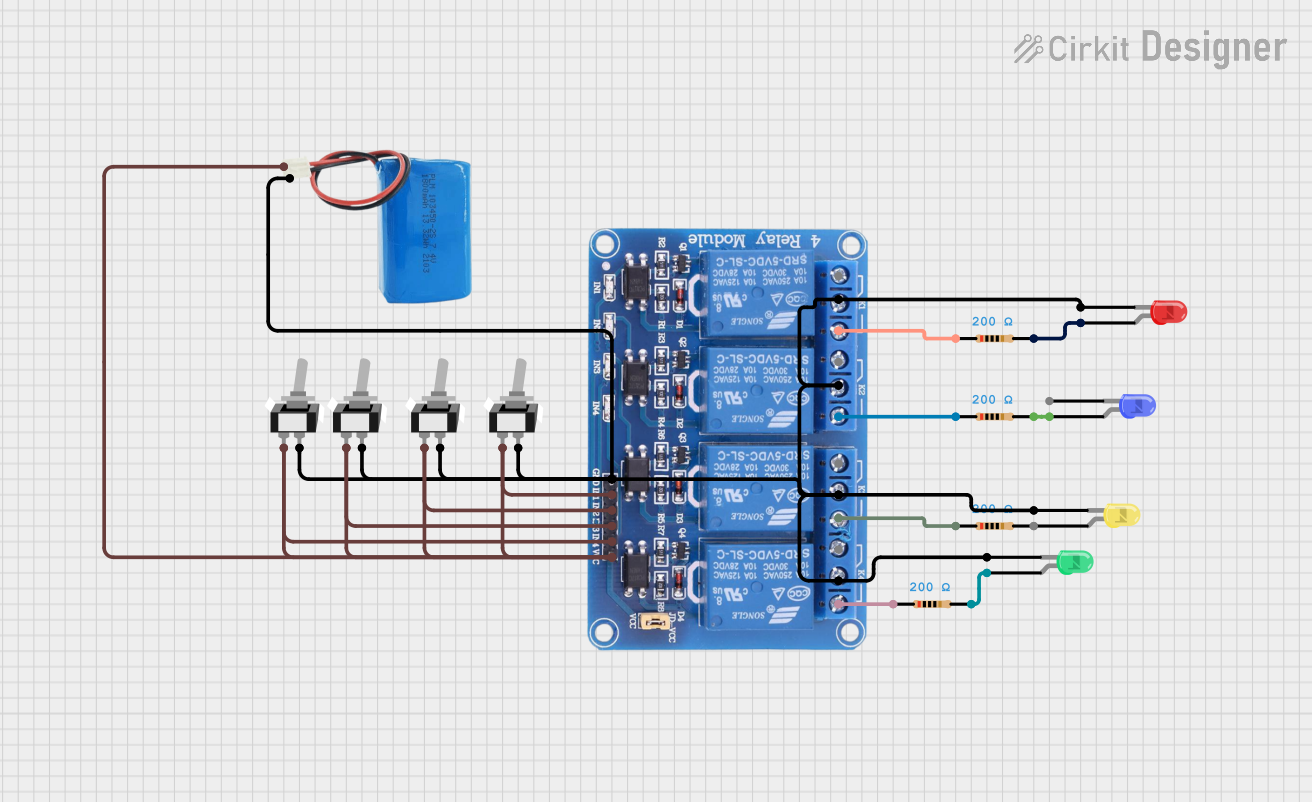
 Open Project in Cirkit Designer
Open Project in Cirkit Designer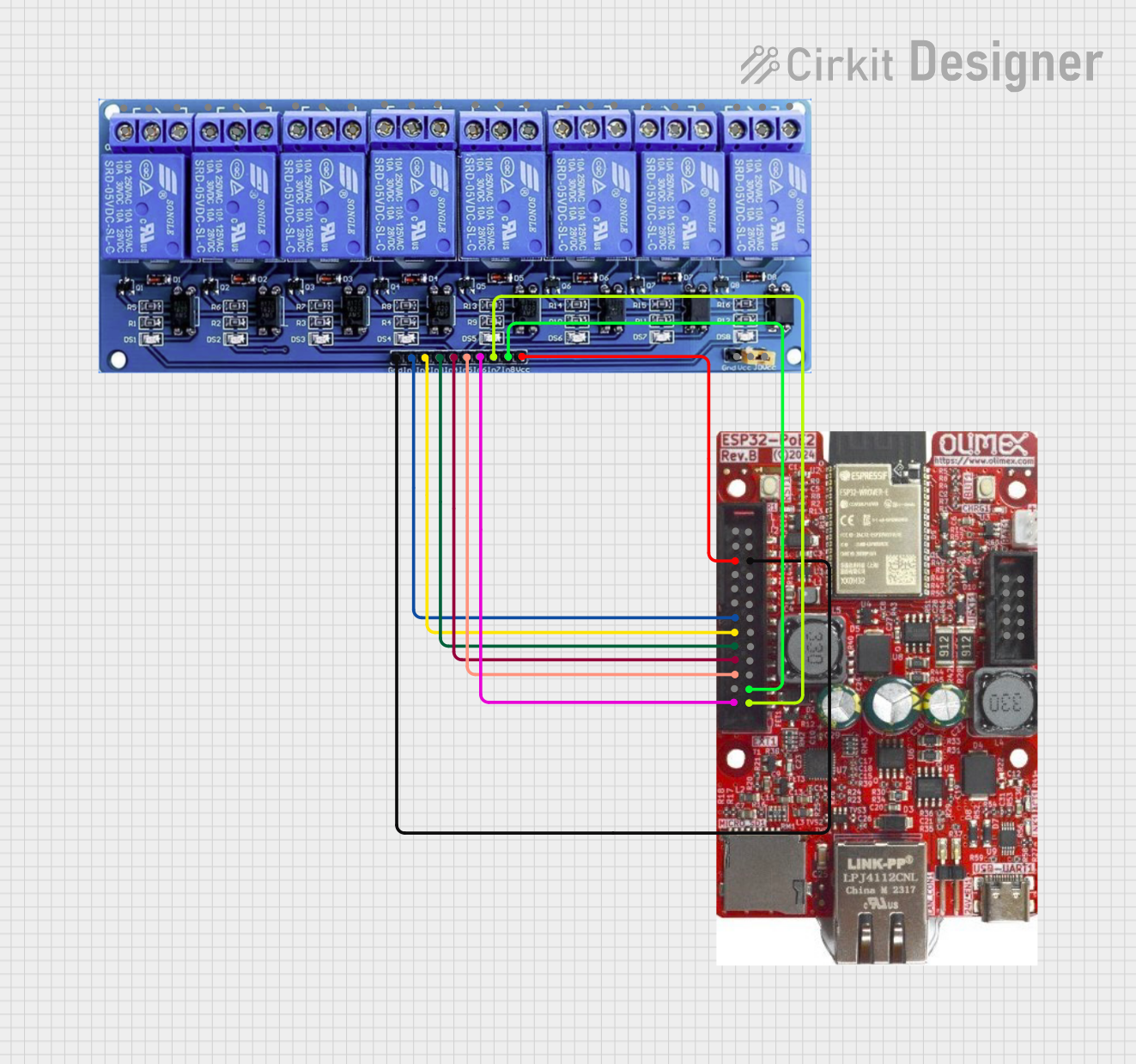
 Open Project in Cirkit Designer
Open Project in Cirkit Designer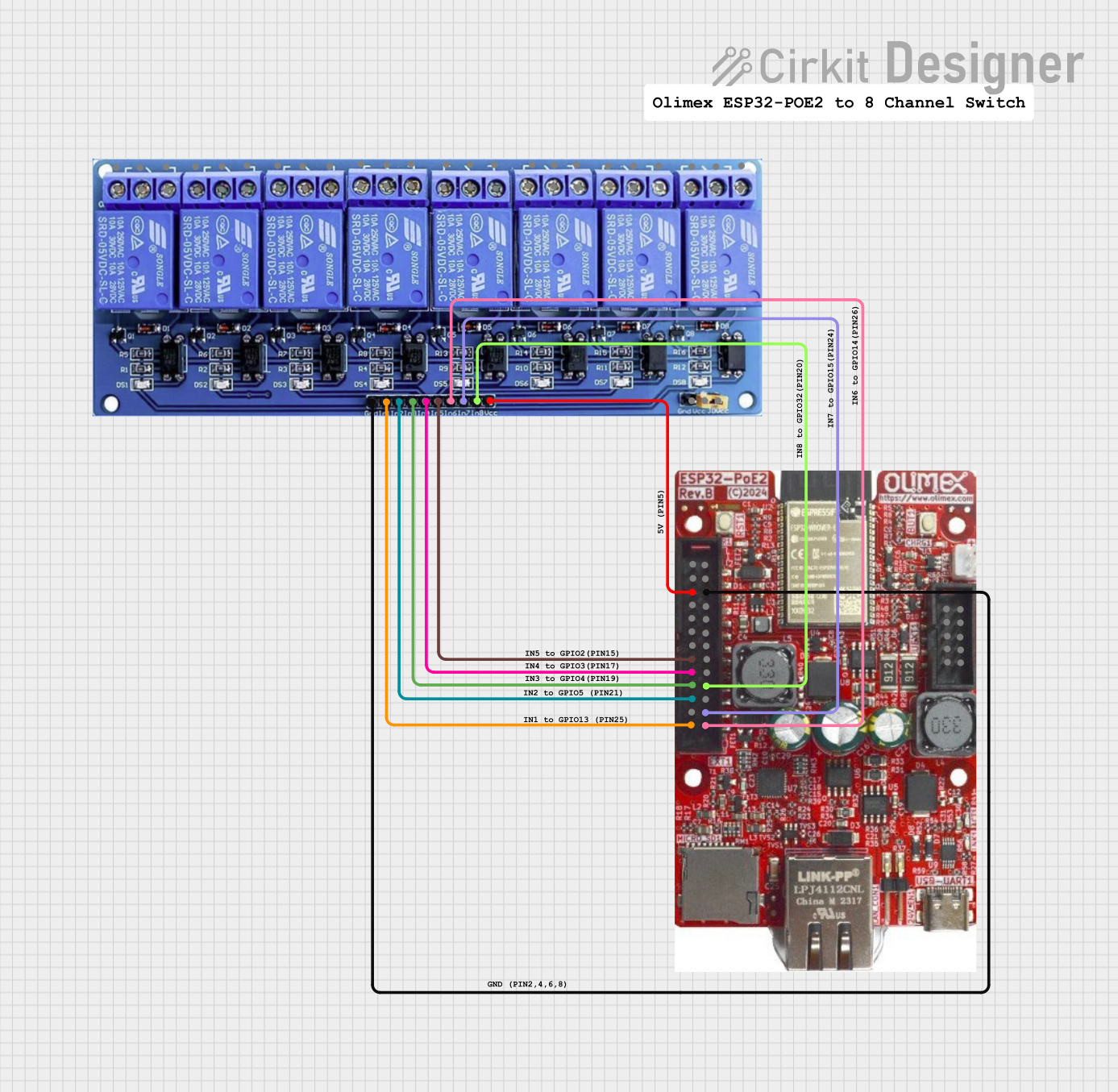
 Open Project in Cirkit Designer
Open Project in Cirkit DesignerExplore Projects Built with 4 channel relay module 5V JD-VCC

 Open Project in Cirkit Designer
Open Project in Cirkit Designer
 Open Project in Cirkit Designer
Open Project in Cirkit Designer
 Open Project in Cirkit Designer
Open Project in Cirkit Designer
 Open Project in Cirkit Designer
Open Project in Cirkit DesignerCommon Applications and Use Cases
- Home automation systems (e.g., controlling lights, fans, or appliances)
- Industrial automation and control
- Robotics and IoT projects
- Switching high-power devices (e.g., motors, pumps) with low-power microcontrollers
- Smart home projects integrated with Arduino, Raspberry Pi, or other microcontrollers
Technical Specifications
Key Technical Details
- Operating Voltage (Control Signal): 5V DC
- Relay Voltage (JD-VCC): 5V DC
- Trigger Current (per channel): 15-20mA
- Relay Type: SPDT (Single Pole Double Throw)
- Maximum Load (per channel):
- AC: 250V at 10A
- DC: 30V at 10A
- Optocoupler Isolation: Yes
- Number of Channels: 4
- Dimensions: Approximately 75mm x 55mm x 20mm
- Indicator LEDs: One per channel (lights up when the relay is active)
Pin Configuration and Descriptions
The module has two sets of pins: control pins and relay output terminals.
Control Pins
| Pin Name | Description |
|---|---|
| VCC | Connect to the 5V power supply of the microcontroller. |
| GND | Ground connection. |
| IN1 | Control signal for Relay 1 (active LOW). |
| IN2 | Control signal for Relay 2 (active LOW). |
| IN3 | Control signal for Relay 3 (active LOW). |
| IN4 | Control signal for Relay 4 (active LOW). |
| JD-VCC | Power supply for the relay coils (5V). |
| Jumper Cap | Used to connect VCC and JD-VCC for shared power. Remove for isolated operation. |
Relay Output Terminals
Each relay has three output terminals:
| Terminal | Description |
|---|---|
| NO (Normally Open) | Open circuit when the relay is inactive; closed when the relay is active. |
| COM (Common) | Common terminal for the relay. |
| NC (Normally Closed) | Closed circuit when the relay is inactive; open when the relay is active. |
Usage Instructions
How to Use the Component in a Circuit
Power the Module:
- Connect the VCC pin to a 5V power supply and GND to ground.
- For isolated operation, connect a separate 5V power supply to JD-VCC and remove the jumper cap.
Connect the Control Signals:
- Connect the IN1, IN2, IN3, and IN4 pins to the digital output pins of a microcontroller (e.g., Arduino).
- The relays are triggered by a LOW signal (0V).
Connect the Load:
- For each relay, connect the device you want to control to the NO, NC, and COM terminals as needed.
- Example: For a light bulb, connect one wire to COM and the other to NO.
Write the Control Code:
- Use the microcontroller to send LOW signals to the IN pins to activate the relays.
Important Considerations and Best Practices
- Isolation: For better safety and noise reduction, use a separate power supply for JD-VCC and remove the jumper cap.
- Inductive Loads: When switching inductive loads (e.g., motors), use a flyback diode across the load to prevent voltage spikes.
- Current Ratings: Ensure the connected load does not exceed the relay's maximum current and voltage ratings.
- Active LOW Trigger: Remember that the relays are activated by a LOW signal, not HIGH.
Example Code for Arduino UNO
// Example code to control a 4 Channel Relay Module with Arduino UNO
// This code toggles each relay ON and OFF with a 1-second delay.
#define RELAY1 2 // Connect IN1 to digital pin 2
#define RELAY2 3 // Connect IN2 to digital pin 3
#define RELAY3 4 // Connect IN3 to digital pin 4
#define RELAY4 5 // Connect IN4 to digital pin 5
void setup() {
// Set relay pins as OUTPUT
pinMode(RELAY1, OUTPUT);
pinMode(RELAY2, OUTPUT);
pinMode(RELAY3, OUTPUT);
pinMode(RELAY4, OUTPUT);
// Initialize all relays to OFF (HIGH state)
digitalWrite(RELAY1, HIGH);
digitalWrite(RELAY2, HIGH);
digitalWrite(RELAY3, HIGH);
digitalWrite(RELAY4, HIGH);
}
void loop() {
// Turn each relay ON and OFF with a delay
digitalWrite(RELAY1, LOW); // Relay 1 ON
delay(1000); // Wait 1 second
digitalWrite(RELAY1, HIGH); // Relay 1 OFF
digitalWrite(RELAY2, LOW); // Relay 2 ON
delay(1000); // Wait 1 second
digitalWrite(RELAY2, HIGH); // Relay 2 OFF
digitalWrite(RELAY3, LOW); // Relay 3 ON
delay(1000); // Wait 1 second
digitalWrite(RELAY3, HIGH); // Relay 3 OFF
digitalWrite(RELAY4, LOW); // Relay 4 ON
delay(1000); // Wait 1 second
digitalWrite(RELAY4, HIGH); // Relay 4 OFF
}
Troubleshooting and FAQs
Common Issues and Solutions
Relays Not Activating:
- Cause: Insufficient power supply or incorrect wiring.
- Solution: Ensure the VCC and JD-VCC pins are connected to a stable 5V power source. Check the GND connection.
Microcontroller Resets When Relays Activate:
- Cause: Voltage spikes or insufficient power supply.
- Solution: Use a separate power supply for JD-VCC and remove the jumper cap. Add a capacitor across the power supply to stabilize it.
Relay LED Lights Up, but Load Does Not Switch:
- Cause: Incorrect wiring of the load to the relay terminals.
- Solution: Verify the connections to the NO, NC, and COM terminals.
Relays Stay ON or OFF Unexpectedly:
- Cause: Electrical noise or floating input pins.
- Solution: Use pull-up or pull-down resistors on the IN pins to stabilize the control signals.
FAQs
Can I use this module with a 3.3V microcontroller?
- Yes, but you may need a level shifter or transistor to ensure the control signals are compatible with the 5V relays.
What happens if I exceed the relay's current rating?
- Exceeding the current rating can damage the relay contacts and cause overheating. Always stay within the specified limits.
Can I control AC and DC loads simultaneously?
- Yes, as long as each load is connected to a separate relay and does not exceed the relay's ratings.
Is the module safe for high-voltage applications?
- The module is designed for high-voltage applications, but proper insulation and safety precautions must be followed.